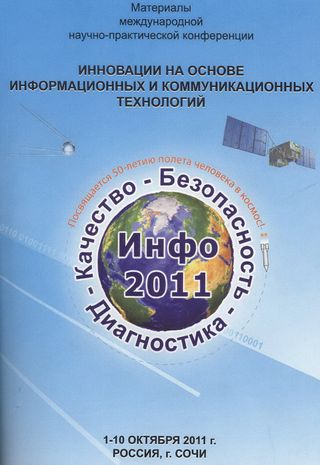?
Двойная случайность в стохастическом моделировании
С. 191-192.
Хакимуллин Е. Р., Энатская Н. Ю.
Приведены алгоритмы моделирования двойной случайности, т.е. вероятностных объектов и их значений с целью расширения рассмотрения исходных моделей для получения более общих прогнозов изучаемых процессов.
Додунова Л. К., Савихин С. А., Известия высших учебных заведений. Математика 2012 № 9 С. 3-7
Исследуется вопрос о полноте лакунарных систем многочленов Фабера специального вида ...
Добавлено: 19 сентября 2023 г.
Волкова Т. В., М. : НИЦ Инфра-М, 2021
Большой математический формализм изложения классических учебников не подходит для восприятия современного студента. Поэтому в своем курсе я старалась добиться более упрощенного и сжатого изложения материала. Достигалось это с помощью более наглядного, часто геометрического изложения как основных понятий, так и доказательств. При этом при геометрическом определении основных понятий всегда делалось их сведение к принятому в стандартном ...
Добавлено: 19 января 2022 г.
Серия «Университеты России» позволит высшим учебным заведениям нашей страны использовать в образовательном процессе издания (в том числе учебники и учебные пособия по различным дисциплинам), подготовленные преподавателями лучших университетов России и впервые опубликованные в издательствах университетов. Все представленные в этой серии работы прошли экспертную оценку учебно-методического отдела издательства и публикуются в оригинальной редакции.
Данное учебное пособие представляет ...
Добавлено: 2 июля 2018 г.
Энатская Н. Ю., Труды Карельского научного центра Российской академии наук 2020 № 7 С. 110-119
Изучается схема n-размерных подстановок с k циклами по направлениям перечислительной комбинаторики. Это перечисление исходов схемы с определенной дисциплиной их нумерации, нахождение их числа, установление взаимнооднозначного соответствия видов исходов с их номерами, называемое задачей
нумерации в прямой и обратной постановках, и моделирование исходов схемы. ...
Добавлено: 17 октября 2020 г.
Галкин С. С., Belmans P., Mukhopadhyay S., / Cornell University. Series math "arxiv.org". 2020. No. 2009.05568.
We introduce graph potentials, which are Laurent polynomials associated to (colored) trivalent graphs. These graphs encode degenerations of curves to rational curves, and graph potentials encode degenerations of the moduli space of rank 2 bundles with fixed determinant. We show that the birational type of the graph potential only depends on the homotopy type of ...
Добавлено: 15 апреля 2021 г.
Загвоздина К. О., В кн. : Межвузовская научно-техническая конференция студентов, аспирантов и молодых специалистов им. Е.В. Арменского. : М. : МИЭМ НИУ ВШЭ, 2019. С. 46-47.
Данное исследование посвящено задаче определения
влияния двух решётчатых моделей конформационного
пространства и пространства последовательностей белковых макромолекул (модели Изинга и HP-модели) на геометрические свойства случайных блужданий без самопересечений. Анализ проведён на основе средних квадратов
радиуса и радиуса инерции. Максимальная длина последовательности равна 10. ...
Добавлено: 31 октября 2019 г.
Davydov Y., Конаков В. Д., , in : Modern problems of stochastic analysis and statistics - Selected contributions in honor of Valentin Konakov. : Heidelberg : Springer, 2017. P. 3-24.
Добавлено: 9 декабря 2017 г.
В работе определяется свободная энергия связывания двух молекул РНК и обсуждаются такие ста тистические свойства, как флуктуации средней энергии связывания двух молекул РНК и распреде ление длин петель в образованной структуре. Анализ зависимости удельной свободной энергии комплекса двух длинных случайных молекул РНК от числа с типов нуклеотидов позволил выдви нуть гипотезу о выделенной роли используемого ...
Добавлено: 19 ноября 2013 г.
Мхитарян В. С., Черепанов Е. В., М. : КУРС, 2017
В монографии изложен нетрадиционный подход к стохастическому моделированию неоднородных социально – экономических совокупностей. Основное место в работе занимают оригинальные методы вероятностно – статистического анализа случайных выборочных наблюдений. В работе рассмотрены новые методы решение задач выборочных исследований, а также: анализа полноты и достоверности эмпирических таблиц количественных данных; прогнозирования экономической динамики по короткой ретроспективе наблюдений; многомерной систематизации и выявления уровня (качества) ...
Добавлено: 3 февраля 2017 г.
Панов В. А., Маркова А. Р., В кн. : Математическое моделирование в экономике, страховании и управлении рисками: сборник материалов IV Международной молодежной научно-практической конференции. Т. 1.: Саратов : Издательство Саратовского университета, 2015. С. 171-176.
В данной статье рассмотрена процедура построения модели волатильности COGARCH с непрерывным временем. Процедура построения модели описана как в общем случае, когда для построения модели используется любой процесс Леви, так и в частном случае составного процесса Пуассона. ...
Добавлено: 8 декабря 2015 г.
В данном пособии подробно рассматриваются вопросы теории рядов, а также разбираются практические задачи. Учебное пособие предназначено для студентов всех специальностей. Для освоения изложенного материала требуется знание основ математического анализа, в частности, теории пределов. ...
Добавлено: 18 сентября 2021 г.
Родригес Залепинос Р. А., PROCEEDINGS OF THE VLDB ENDOWMENT 2022 Vol. 15 No. 12 P. 3742-3745
Добавлено: 30 августа 2022 г.
Ивченко Г. И., Соболева М. В., Дискретная математика 2011 Т. 23 № 3 С. 23-31
Рассматривается двухпараметрическая модель случайных n-подстановок, обобщающая классическую модель А-подстановок, для которой изучается совместное распределение чисел А-циклов и -циклов при различных конкретизациях подмножества . ...
Добавлено: 12 апреля 2012 г.
Молчанов С. А., Куценко В. А., Яровая Е. Б., Успехи математических наук 2023 Т. 78 № 5(473) С. 181-182
Условия надкритичности для ветвящихся блужданий в случайной убивающей среде с единственным центром размножения. ...
Добавлено: 3 ноября 2023 г.
Афендикова Н. Г., Омельченко И. Н., Рыжаков Г. В. и др., М. : ВУНЦ ВВС «ВВА им. проф. Н.Е. Жуковского и Ю.А. Гагарина», 2011
Учебно-методическое пособие в трех частях предназначено для студентов-иностранцев. Оно содержит примеры решения и подборку задач по дисциплине «Математический анализ» и охватывает основные разделы данной дисциплины. В каждой теме разобраны примеры решения типовых задач, в конце каждой темы приведены задачи для самостоятельного решения. Задачи снабжены ответами. Третья часть пособия содержит разделы и темы, относящиеся к теории ...
Добавлено: 6 февраля 2013 г.
Davydov Y., Конаков В. Д., / Cornell University. Series math "arxiv.org". 2016. No. 1609.07066.
Добавлено: 23 сентября 2016 г.
Швец С. К., Известия Санкт-Петербургского государственного экономического университета 2015 № 5 С. 72-77
В статье осуществлен анализ метрик оценки рисков в нефинансовых компаниях, выявлены ключевые детерминанты стоимостных метрик RiskMetrics, CorporateMetrics и Stress-testing. Рассмотрены методические аспекты разработки интегральной метрики оценивания рисков с использованием имитационного моделирования (метод Монте-Карло) ...
Добавлено: 12 марта 2016 г.
Конаков В. Д., Menozzi S., / Cornell University. Series arXiv "math". 2023. No. 2312.06222.
Добавлено: 12 декабря 2023 г.
